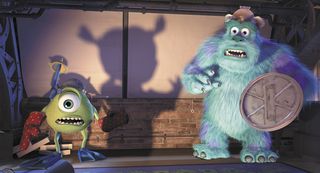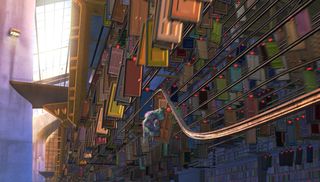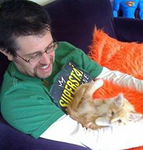http://www.youtube.com/watch?v=ZhTb-gvUOEk&feature=youtu.be
Pixar doesn’t convert movies to 3D. It recreates them in 3D. That’s the term Stereoscopic Supervisor Bob Whitehill prefers to use, and when SFX got to chat with him recently about his work on Monster, Inc 3D (currently on release in the UK) it rapidly became clear there’s nothing self-aggrandising about the claim. If you thought adding an extra dimension to a Pixar film was just a case of downloading the original film files and running them through Adobe Make3D or somesuch, you’re in for a big surprise at how much effort, care and attention it actually takes…
“It took about six months on Monsters, Inc to just go back and get the film operational in today’s software.
“And rather than just taking the 2D images and carving them up and converting them into 3D space, we had the ability to resurrect these movies and re-film them, essentially, in 3D – that’s the route we wanted to take.
“And then there was about another six months of the recreation process, where we go in and set all the 3D parameters. Much like a sound mixer will raise and lower different levels of audio on certain aspects, we were able to pick and choose and raise or lower the level of 3D on each shot. Sort of like a visual accordion, spreading it in and out. So we’ll go through it and make those creative decisions.”
So how much artistic control do you actually have? What differences can you make on an artistic level rather than just a technical level?
“You shy away from any big changes. We’re not adding new shots. We haven’t combined shots. We do very slight camera adjustments, though. For instance, if you have a camera that’s really low on the ground, the you might be dedicating all your 3D space to carpet. Your characters are way back in the screen in 3D space, so they look kinda flat. So what we might do is raise the camera off the ground a little bit so that we can spread that 3D space across the characters, making Mike looking rounder instead of just having a really great shot of a carpet.
“So those are the kind of little things that we do. We don’t change the length of shots of the animation. We’ve done a few things where we’ll change a character if the character is reaching towards the camera; we might slightly change the animation to keep their fingers in frame. It breaks the illusion if something is reaching towards you and then goes off the side of the screen.
Is the film’s original director Pete Docter involved in the process?
“He is, yeah. We’ll have an initial kick off with Pete and describe what we plan to do with the movie. And then we show them in individual chunks - usually about 18 minute chunks at a time – to make sure that we’re on the right track as far as what they envisioned what their film would look like in 3D.”

I read that on the “3D recreation” of Finding Nemo, the particle matter in the sea posed a challenge. The original animators inserted it to give the underwater scenes a sense of volume, but when it came to recreating the film in 3D you had to tone down the particles because they could overload the 3D image. Were there similar challenges on Monster, Inc ?
“We did have the Himalayas scene with the falling snow. That represented a similar challenge to the particle matter in Nemo , where you needed it to give the scene volume but not be over the top.
“Other challenges were, I think, at times we ran into some challenges with depth of field. In 3D space when things are blown very out of focus and blurry, it can actually draw your eye to the out-of-focus object rather than do the opposite, which is push your eye towards what’s in focus.
“It’s an odd sensation. Imagine an over-the-shoulder shot. So we’re looking at Mike – Mike’s facing the camera – but we’re looking over Sully’s shoulder, and his blue and purple fur is dramatically out-of-focus in the foreground. We’re so used to – in real life – being able to look at something and bring it into focus. We do that our entire lives. As we scan a room we bring the object we’re looking at into focus. But we’re unable to bring something into focus when we’re looking at in on a movie screen. And that can be a little jarring in 3D.
“So sometimes we would, what we call, broaden the depth of field. Make it a little less blurry to make it easier to view.”

If there’s one scene in Monsters, Inc that looks made for 3D it’s chase through the vault of doors at the climax. Was that one of the scenes you were looking forward to recreating?
“It really was. It was a highlight of the production. We had an early initial review with John Lasseter to show him how the film was coming together. And initially we were going to show him the first 15 minutes of the movie or so. But then we got together and we thought, ‘Well, let’s show him a little bit of the door vault too.’ So we identified about 90 seconds of that scene to bring forward in production to show him what was coming up.
“And just to watch that come together – especially that signature shot of Mike and Sully on the door as we pan with them from right to left as they sail into that enormous space of the vault – it just really works well. That is probably the highlight of the movie in 3D space.
“John always said that we made our movies envisioning them in 3D and now we have the projection technology to share it with the world. He’s really keen on how 3D can add to the immersion and the storytelling. These films were designed with 3D in mind.”
Do you think 3D works better with animated films?
“You know, I think we have a great advantage in animation, in that our cameras are essentially just computer code. The left and right eye images can be rock solid the same, other than the 3D effect that we intend.
“Whereas live action has a bit of a challenge in that they have two lenses there; two cameras on set. And so those lenses might be slightly different. You might have a slightly different focus level or – heaven forbid – a vertical disparity. So yeah, live action does have challenges that we don’t have in terms of matching their left and right eye images exactly.
“We also have the benefit in our medium of being able to do the 3D over and over and over until we feel we’ve got it right. In live action you cannot do 20 different takes of every single shot . Eventually they’re going to have to call wrap on the set and move on.
So when the next big technological revolution in cinema happens, are Pixar films uniquely ready to be recreated again?
“That’s a good question. It’s funny, you know – we’ve gone through this resurrection process with Nemo and Monsters Inc , and we’ve tried to archive them in such a way that we’ve future-proofed them. We joke about the 360-dgree hologram version we’ll make in 10 years, so let’s make sure everything’s stored properly.
“While doing this process we would run into files that would be buried deep down on somebody’s personal hard drive, so you just have to hope that person’s still with Pixar and find some thing that they created 12 years ago. But now we’re trying to make sure that all that stuff is accessible and properly archived so that we can recreate the 360 degree hologram version of the future.”
What classic films you would like to see in 3D?
“Wow. I’d be thrilled to see the original three Star Wars movies in 3D. Raiders Of The Lost Ark would be a great 3D movie. So many. I really believe in it. It doesn’t have to over-the-top and life-changing, but to me any movie in 3D space, if it’s done gracefully and it’s connected to the story, I think it enhances the experience. If it’s projected properly and you have some good glasses why would you not want to see it in 3D?”

